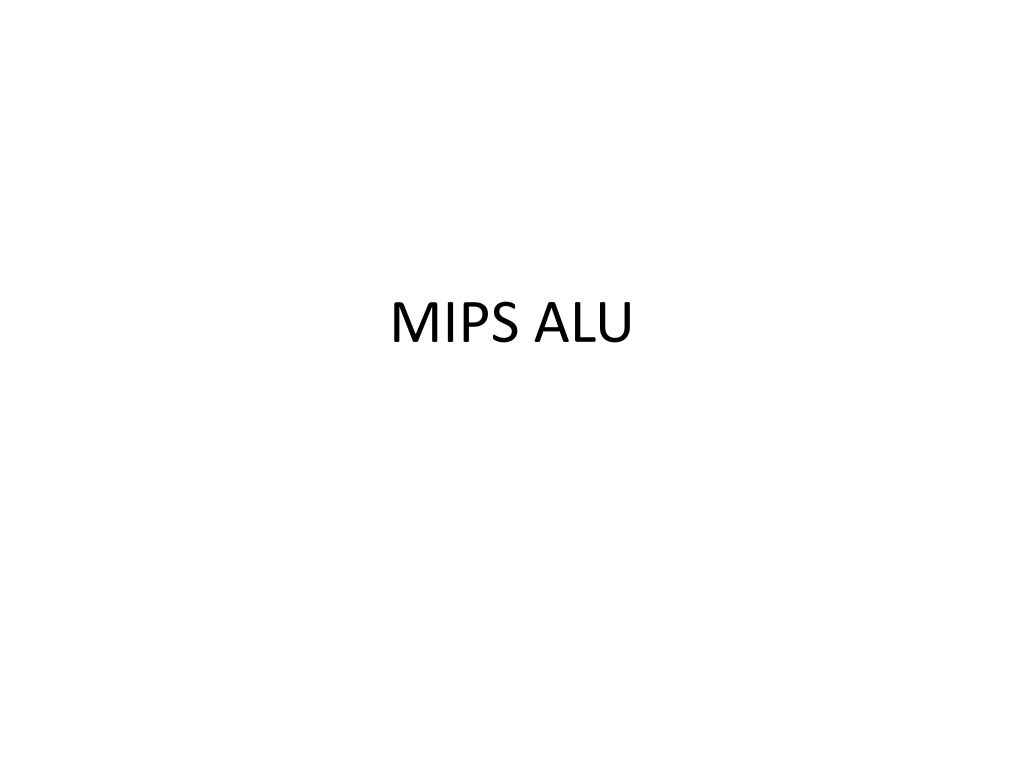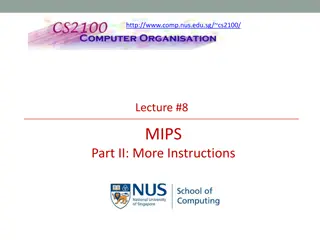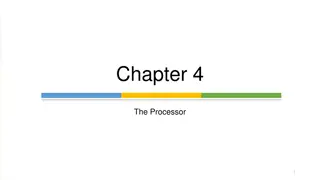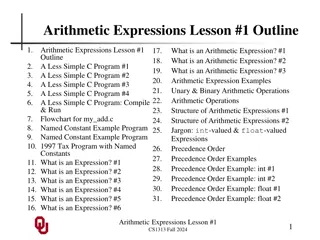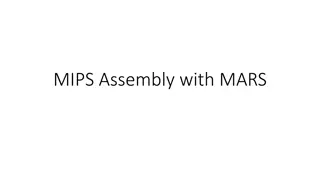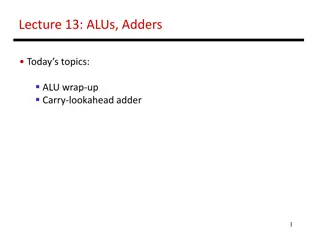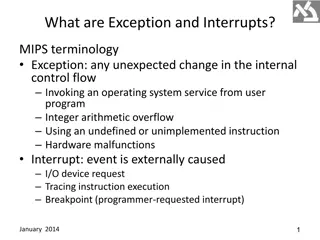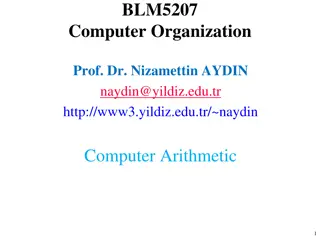Understanding MIPS Arithmetic Logic Unit (ALU)
The MIPS ALU is the heart of computer calculations, performing functions like add, and, or, and sub. This article delves into designing a full ALU, starting from a 1-bit full adder to a 32-bit ALU. It explores how operations like and, or, and addition are carried out within the ALU, and how to implement subtraction using two's complement representation. The process of building a 32-bit ALU with 1-bit ALU components is also explained, emphasizing on handling basic functions first and then combining them.
Download Presentation

Please find below an Image/Link to download the presentation.
The content on the website is provided AS IS for your information and personal use only. It may not be sold, licensed, or shared on other websites without obtaining consent from the author. Download presentation by click this link. If you encounter any issues during the download, it is possible that the publisher has removed the file from their server.
E N D
Presentation Transcript
Building from the adder to ALU ALU Arithmetic Logic Unit, does the major calculations in the computer, including Add And Or Sub In MIPS, the ALU takes two 32-bit inputs and produces one 32-bit output, plus some additional signals Add is only one of the functions, and in this lecture, we are going to see how an full ALU is designed
Review 1-bit full adder
Building 32-bit ALU with 1-bit ALU Build 32-bit ALU with 1-bit ALU. Deal with the easy ones first and and or
And and Or operations And a b And result Or a b Or result
Putting them together Sometimes the instruction is add, sometimes it is or, sometimes is and, how to put them together? In MIPS instructions, there are many fields: op, funct, rs, rt, rd, shamt
Putting them together Just do everything (add, and, or) and then select one AS the output with a selector.
Subtraction? How to implement subtraction?
Subtraction Using two s complement representation, we can implement subtraction through addition The reason is that a negative number -b in 2 s complement is actually 2n-b. So if you do a+2n-b and take only the lower n bits, it becomes a-b because 2nis a one bit at bit n (bit indices are 0,1,2, , n-1, n). What do we need to add to the ALU we have in order to be able to perform subtraction? 11
1-Bit ALU That can Do Subtraction To do a-b, three things: 1. Invert every bit of b. 2. Add 1. 3. Add with a. So, if it is a subtraction, invert the second operand, set the CarryIn of the last one-bit full adder to be 1, then select the adder output. 12
Subtraction Notice that every time we want the ALU to subtract, we set both CarryIn and Binvert to 1. For add or logical operations, we want both control lines to be 0. We can therefore simplify control of the ALU by combining the CarryIn and Binvert to a single control line called Bnegate.
Supporting Branch Instructions We need to be able to test if two numbers are the same 14
Supporting Set Less Than Set less than instruction produces 1 if rs < rt, and 0 otherwise It needs to set all but the least significant bit to 0 The least significant bit is set according to the comparison Which can be done using subtraction That is, do a subtraction, check the sign bit (bit 31). 15
Complication If we only use the sign bit of the adder, sometimes we will be wrong For the following example (using 4 bits only), we have Then we have , which is clearly wrong ten 6 7 ten 16
Overflow The problem is that sometimes we have overflow. If we have only 4 bits, a number greater than 7 or a number less than -8 will cause an overflow because it cannot be represented in 4 bits. In the previous example, -7-6=-13, overflow.
Dealing with overflow Overflow happens when the two numbers are of the same sign. If they are of different signs, the addition result will be less than the larger one (the absolute value) and should be still within the range, assuming the two original numbers are within the range.
Overflow Detection One way to detect overflow is to check whether the sign bit is consistent with the sign of the inputs when the two inputs are of the same sign if you added two positive numbers and got a negative number, something is wrong, and vice versa. 19
Dealing with overflow For two positive numbers, after the addition, The carryout of ALU31 must be 0, because in 2 s complement, positive numbers go from 000 1 to 011..1. The largest number is 011 1 and adding two 011 1 will lead to 111 10, the carry out is still 0. if no overflow, the sign bit (bit 31) should be 0, because the result is a positive number. If overflowed, the sign bit (bit 31) will be 1, caused by a carryin to ALU31.
Dealing with overflow For two negative numbers, after the addition, The carryout of ALU31 must be 1, because in 2 s complement, negative numbers go from 100 0 to 111..1. Even if you are just adding two 100 0, you will have 1000 00, the carry out is 1. if no overflow, the sign bit (bit 31) should be 1, because the result is a negative number. If overflowed, the sign bit (bit 31) will be 0, caused by having no carryin to ALU31.
Overflow Detection So, we can detect the overflow by checking if the CarryIn and CarryOut of the most significant bit are different 22
Overflow The sign bit is correct if there is no overflow If there is overflow, the sign bit will be wrong and needs to be inverted 23
Final 32-Bit ALU
Final 32-Bit ALU ALU control lines are 1-bit Ainvert line, 1-bit Bnegate line, and 2-bit operation lines 26
ALU Symbol 27
